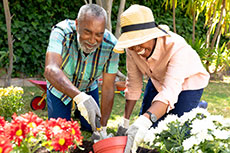
Find out how you can reduce the risk of landing fall-related injury
The start of the fall equinox in September is a good reminder to consider your risk of falling, and learn more about steps you can take to prevent a fall.
According to the U.S. Centers for Disease Control and Prevention (CDC) one in four Americans aged 65+ falls each year. These falls result in more than 3 million injuries treated in emergency departments annually, including over 800,000 hospitalizations.
The fact is, falling does not need to be a normal part of the aging process. Falls can be caused by many things that are common as we age, including:
- Vision and/or hearing loss
- Slower reflexes
- Muscle weakness
- Chronic health conditions like diabetes
- Side effects from medications
Regardless of age, there are things you can do to help make yourself (and your loved ones) safer. The National Council on Aging (NCOA) suggests these tips to prevent a fall:
Be intentional about functional fitness
Jennifer Menk, the Y’s Senior Director of Health & Wellbeing stresses the importance of functional fitness, “Exercises that mimic daily life, and enable people to move well and pain free.” Jennifer says that preventatively moving your body through all planes of motion and ranges of motion will help you avoid unnecessary muscle pulls and the like. She suggests that if you do a daily walk, try to change up the terrain so that your body works to walk on gravel, sidewalks, and inclines.
For some, “functional fitness” can conjure up images of intense exercise, however, Robin Hedrick, Director of Community Health at the Y says, “Functional fitness can be small, simple steps taken each day.” Consider the things you do, and want to keep doing. For example:
- Using the stairs in your home (if you have them)
- Carrying groceries and putting them away
- Getting out of bed and off the couch
- Getting down to the ground and back up again—especially if you have a hobby like gardening
In addition to regular physical activity, consider intentionally setting aside time to support your functional fitness by focusing on core strength, stability, balance and range of motion.
Find a good balance and exercise program
Some think that limiting activity is one way to reduce the risk of falling. However, this is a myth—staying physically active is one of the best things you can do to limit the risk of falling. With regular physical activity, be mindful of changing things up to help keep your body engaged and work toward using your whole body. The benefits of regular physical activity are bountiful, and especially as it relates to preventing falls, it helps quite a bit with joint stability and maintaining muscular strength.
For Y members, you can stop in at your local YMCA for a free fitness assessment and/or balance assessment to help you ensure you’re engaging in the physical activities that will support your efforts in preventing a fall. You might also try a Group Exercise class that helps build muscle, or Tai Chi, Pilates and Yoga for better balance.
Regularly review your medications with your doctor or pharmacist
Especially when starting a new medication, or changing medication doses it is important to understand how the side effects can potentially increase your risk of falling. For example, dizziness and drowsiness are common side effects that are often linked to falls.
Get your vision and hearing checked annually
Aging is associated with some forms of vision loss, which can increase the risk of falling and injury. People with vision problems are more than twice as likely to fall as those without visual impairment.
Make your living environment safe
Remove tripping hazards—think clutter and throw rugs, increase lighting, add railings to both sides of stairs and install grab bars in key areas like inside the shower and next to the toilet. While inside, it’s a good idea to wear supportive shoes or slippers with non-slip soles. Outdoors, have sand or salt spread on icy areas during the winter.
Ask your health care provider for an assessment of your risk of falling
If you need help feeling steady when you walk, your health care provider might recommend using an assistive device like a cane or walker. To give yourself a quick idea on your potential risk, try this NCOA online tool or get the CDC’s printable checklist.